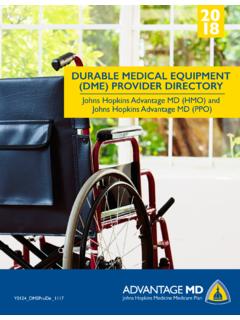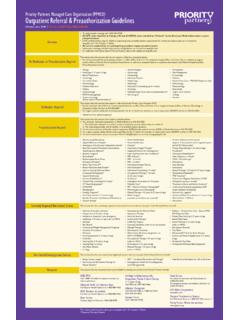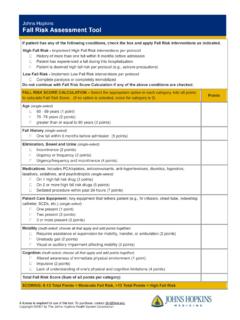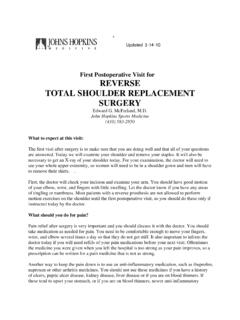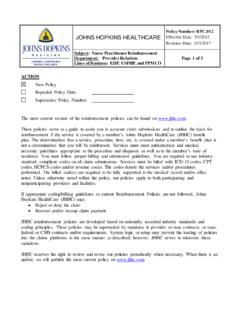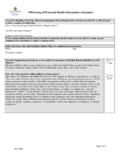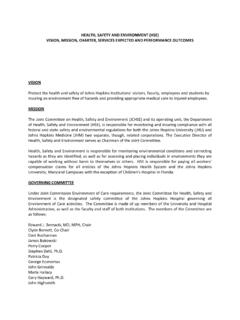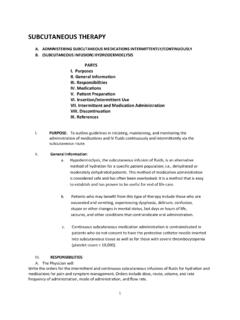Transcription of Johns Hopkins Health System and Office ... - Hopkins Medicine
1 Johns Hopkins Health System and Office of Injection and infusion Services Johns Hopkins Physicians Coding Policy Number: OUT001 Effective Date: 07/01/2019 I. INTRODUCTION The purpose of this coding guidance is to provide assistance and direction with coding determinations for the Johns Hopkins Health System (JHHS) and Office of Johns Hopkins Physicians (OJHP). These notifications are to be made available to all staff members involved in the coding and reporting of infusion and injection services. This recommendation has been vetted and approved. The certified coding professional should refer to the applicable Official ICD-10-CM Guidelines for Coding and Reporting as well as follow all instructions in the coding manuals, as the notification may not be all inclusive.
2 The Centers for Medicare & Medicaid Services (CMS) considers Coding Clinic, published by the American Hospital Association (AHA), as an official source for coding guidelines for ICD-10 and PCS. Whereas, CPT Assistant published by American Medical Association (AMA) is the official source for proper CPT code usage. Additionally, the American Health Information Management Association (AHIMA), the American Hospital Association (AHA) and the American Association of Professional Coders (AAPC) specify standards for ethical coding and reporting of diagnoses. These reference links are located in Section IV. Associated Documents. II. FINAL GUIDANCE Assign the appropriate ICD-10-CM diagnosis code to identify the reason for injection/ infusion regardless of site of care.
3 For outpatient coding, the reason for the injection/ infusion is the first listed diagnosis for outpatient visits. Also, code any comorbid conditions currently under treatment as additional diagnoses. When the visit is solely for the administration of chemotherapy or immunotherapy, or respectively is the first-listed code followed by the malignancy for which the patient is being treated. Follow CPT guidelines and hierarchy rules, when coding infusion and Injections. The infusion Hierarchy determines initial service. In the doctor s Office (place of service 11), the initial code should be the code that best describes the primary reason for the encounter. In the hospital outpatient clinic (place of service 22), the infusion hierarchy determines the initial service.
4 The order in which an infusion service is rendered during a visit does not determine the initial service. There is only one initial service coded per vascular access site, per encounter/date. Johns Hopkins Health System and Office of Injection and infusion Services Johns Hopkins Physicians Coding Policy Number: OUT001 Effective Date: 07/01/2019 The infusion Hierarchy is as follows: Chemotherapy services are primary to Therapeutic, Prophylactic and Diagnostic services Therapeutic, Prophylactic and Diagnostic services are primary to hydration and the order is: 1. Chemotherapy 2. Therapeutic, prophylactic and diagnostic services 3. Hydration Infusions are primary to pushes which are primary to injections and the order is: 1.
5 Infusions 2. IV push 3. Injection This hierarchy does NOT apply to SubQ/IM injections Chemotherapy administration of non-radionuclide antineoplastic drugs, antineoplastic agents, monoclonal antibody agents for non-cancer diagnosis, such as rheumatologic disorders, and other biologic response modifiers require physician and/or professional clinical staff monitoring because of potential for severe adverse patient reaction. Assign the appropriate code from CPT codes 96401-96549. Note: The administration of an antineoplastic drug, non-radionuclide anti-neoplastic drug, anti-neoplastic agent or certain monoclonal antibodies is coded as a chemotherapy infusion procedure. See approved list of non-chemotherapeutic drugs in the attached APPENDIX A.
6 Therapeutic administration (non-chemo) of therapeutic, prophylactic, or diagnostic IV infusion or injection (other than hydration) for the administration of substances/drugs require direct supervision for patient assessment, consent, and safety oversight. Assign the appropriate code from CPT codes 96365-96379. NOTE: When fluids are used to administer the drug(s), the administration of the fluid is considered incidental hydration and is not separately reported. IV infusions to restore body fluids (hydration) should not be coded with an infusion of drugs or other substances. Hydration infusions require direct supervision for consent and safety oversight. Assign the appropriate hydration code from CPT codes 96360-96361.
7 Infusions may be concurrent ( , multiple drugs are infused simultaneously through the same line) or sequential ( infusion of drugs one after another through the same access site). NOTE: IV infusion differs from an IV push which is defined as an infusion lasting 15 minutes or less. _____ Johns Hopkins Health System and Office of Injection and infusion Services Johns Hopkins Physicians Coding Policy Number: OUT001 Effective Date: 07/01/2019 III. RESEARCH and RATIONALE Source of Inquiry The Johns Hopkins Institutions Office of Hopkins Internal Audits requested an institutional coding guideline that clearly defines hierarchy rules for coding, as well as the proper classification of the infused drug, and addresses whether supplies and other items commonly used for infusion services are separately chargeable Rationale Selecting the Correct CPT Code Follow the CPT guidelines and hierarchy to ensure accurate code selection.
8 A. Start/Stop Time Selection of the correct CPT code is dependent upon the start and stop time of infusion services. If stop time is not documented, only an IV push can be billed. It is therefore important to follow the following guidance: infusion services are coded based on the length of the infusion which is a time based service The Start and Stop times of each medication administration must be accurately recorded, as this determines the correct CPT code assignment The first hour of infusion is weighted heavier than subsequent hours to include preparation time, patient education, and patient assessment prior to and after the infusion The time calculations for the length of the infusion should stop when the infusion is discontinued and restart at the time the infusion resumes Johns Hopkins Health System and Office of Injection and infusion Services Johns Hopkins Physicians Coding Policy Number: OUT001 Effective Date: 07/01/2019 B.
9 Time Documented Time documentation is critical because it drives the assignment and accuracy of the CPT coding of infusion services. Key Time ranges o 15 minutes or less Infusions lasting 15 minutes or less would be coded as an IV push o 16 minutes or more infusion can be reported after 16 minutes o 31 minutes to 1 hour Hydration infusion must be at least 31 minutes in length to bill the service. o 16-90 minutes versus more than 90 minutes 16-90 minutes represents the first hour of infusion services 91 minutes or more represents the subsequent hour of infusion , in intervals greater than 30 minutes beyond 1-hour increments o 30 minutes since last reported push Each additional sequential IVP of same drug/substance must not be reported if within 30 minutes of each other.
10 C. Services Included in the infusion Numerous services are included in the infusion charge. According to coding guidelines supplies are bundled into the infusion services rate and therefore, not billed separately. Included in infusion services are: a. Use of local anesthesia b. Time preparing the drug and prepping the patient c. IV start d. Access to the port e. Prep of chemo agent f. Flush at conclusion, includes heparin flush g. Supplies used during the infusion are not separately billable, Exception: Regulated facilities are exempt and should follow internal guidelines for chargeable supplies. h. Monitoring during waiting time prior or after infusion i. Education of the patient prior to and at the conclusion of the infusion j.
